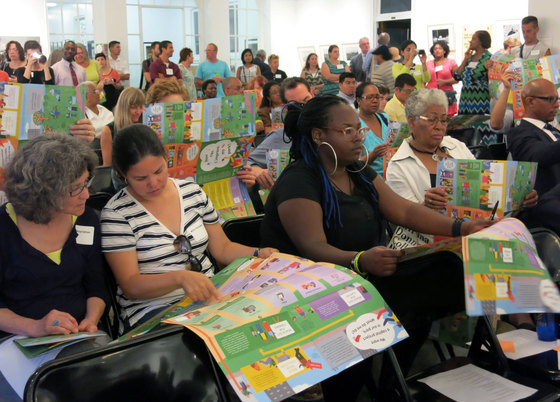Design that breathes life into important regulations
Imagine yourself as a recently-arrested juvenile offender. Or a father on his way to family court. Or a tenant with minimal knowledge of English and a landlord who’s refusing to repair a big leak.
Look for help in some communities and you might be handed a typical brochure or pamphlet outlining concepts and policies you may not fully grasp. You might walk away more confused than ever. If you live in New York City, however, you could get the same information delivered in a way that’s easier to understand as well as more engaging.

People gather at the Center for Urban Pedagogy to celebrate the launch of a guide to park advocacy. From the Center for Urban Pedagogy.
Brooklyn’s Center for Urban Pedagogy focuses on helping people navigate the urban landscape they live in. Instead of delivering messages through traditional, dry writing, the Center has graphic artists create comics, posters, and other dynamic materials that make information pop. Their materials are meant for the entire community, but they’re especially helpful in empowering people at a natural disadvantage—young people, for example, and immigrants who can’t read English.
A few of their creations include:
“I Got Arrested! Now What?”, a comic book story of a young boy’s journey through the juvenile justice system.
Housing Court Help, a guide that includes comic book-style characters negotiating better terms with their landlords.
Rent Regulation Rights, a graphic poster outlining tenants’ rights in both Chinese and English.
To develop even more materials, the Center for Urban Pedagogy has put high school students on the case. In a course taught by an artist, students are sent on urban investigations. As a result, they’ve already put together posters outlining the decisions behind the placement of homeless shelters, how restaurants are graded and how to prepare for a natural disaster. Besides creating interesting materials, the Center also wants to teach community members how to be a part of the decision-making process when it comes to creating their community.
Of course some of the information the Center provides is the sort nobody wants to need. But understanding what you’re up against—and what your rights are—is half the battle. Possibly more than half. Making the information clear (and palatable) makes so much sense you have to wonder why this is such a novel idea.
Hope abounds, though. People at the Center realize other communities want to create similar offerings. They want to help make that happen. Maybe, if you’re lucky, you’ll soon find the same kinds of materials in your own hometown.










